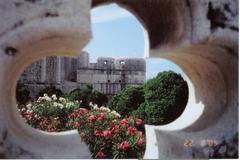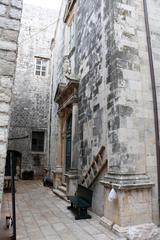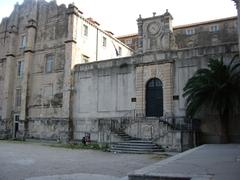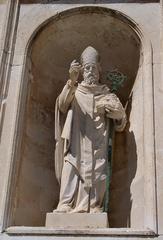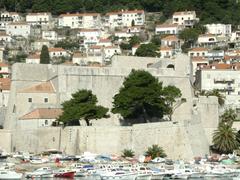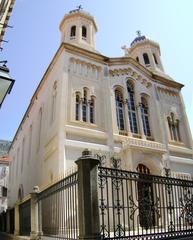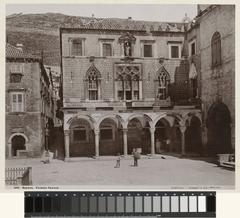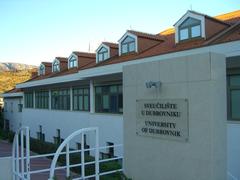Franciscan Church and Monastery Dubrovnik: Visiting Hours, Tickets, and Complete Travel Guide
Date: 14/06/2025
Introduction
Standing as a gateway to Dubrovnik’s UNESCO-listed Old Town, the Franciscan Church and Monastery is one of the city’s most significant spiritual, historical, and architectural landmarks. Founded in the early 14th century after the relocation of the original monastery inside the city walls, this complex has witnessed transformative events—from the flourishing of medieval craftsmanship and Renaissance artistry to Baroque restoration following the 1667 earthquake. Today, it is renowned for its stunning Romanesque cloister, Gothic portal, Baroque interiors, and Europe’s third oldest continuously operating pharmacy. As both a monument to resilience and a living center of worship and learning, the monastery invites visitors to explore centuries of Dubrovnik’s cultural legacy.
This guide offers a detailed overview of the monastery’s history, architecture, cultural significance, practical visitor information (including visiting hours and ticket details), and useful travel tips. For further exploration, visitors can consult official tourism resources and consider guided tours or virtual experiences to deepen their appreciation (dubrovnikcity.com; SpottingHistory; A Luxury Travel Blog).
Contents
- Historical Overview
- Origins and Foundation
- Architectural Evolution: Romanesque, Gothic, Renaissance, and Baroque
- Cultural and Religious Significance
- The Old Pharmacy
- The Library and Museum
- Visitor Information
- Opening Hours & Tickets
- Guided Tours
- Accessibility
- Travel Tips and Nearby Attractions
- Frequently Asked Questions (FAQ)
- Conclusion
- Sources and Further Reading
Historical Overview
Origins and Foundation
The Franciscan order arrived in Dubrovnik in 1234, initially establishing their monastery outside the city walls. In 1317, with increased security concerns, the city authorities moved the friars inside the walls, demolishing the original structure and beginning construction on the present complex (dubrovnikcity.com). This strategic move protected the friars and integrated the monastery into Dubrovnik’s urban and spiritual core.
Architectural Evolution
Romanesque and Gothic Elements
The monastery’s Romanesque cloister, completed in 1360 by Mihoje Brajkov of Bar, is a masterwork of late Romanesque architecture on the Adriatic. Its 120 slender columns, each with a unique carved capital, surround a tranquil garden, creating an atmosphere ideal for contemplation (SpottingHistory; TZ Dubrovnik). The church’s original Gothic portal, crafted in 1498 by Leonard and Petar Petrović, features a pointed arch, a Pietà sculpture, and figures of St. Jerome and St. John the Baptist.
Renaissance and Baroque Transformations
The monastery’s architecture also incorporates Renaissance elements—seen in the balanced proportions and restrained decoration of the museum hall—and was extensively rebuilt in Baroque style after the 1667 earthquake. The church’s Baroque interior includes ornate altars, dramatic lighting, and paintings by old masters, blending earlier elements with the grandeur of later periods (thecrazytourist.com).
Private Cloisters
Besides the main Romanesque cloister, the monastery features a private Gothic cloister reserved for the friars, adding another layer to its architectural complexity (SpottingHistory).
Cultural and Religious Significance
Center for Learning and Healing
The monastery’s library is one of Croatia’s richest, with over 30,000 volumes, 1,200 rare manuscripts, and 216 incunabula, preserving centuries of religious and scientific scholarship (Wikipedia).
The Old Pharmacy
Dating to 1317, the Friars Minor Pharmacy is the oldest functioning pharmacy in Europe and the third oldest in the world (A Luxury Travel Blog). It continues to serve the public, offering unique creams and tinctures made from ancient recipes. The attached museum displays original 16th-century furniture, medieval apothecary jars, and rare pharmaceutical tools (History Hit).
Religious and Social Role
Throughout history, the monastery has been a center for worship, education, and charitable work—especially during times of plague and conflict. It remains an active place of worship and hosts annual festivities that draw both locals and pilgrims (Wikipedia).
Visitor Information
Opening Hours
- Summer (last Sunday in March – last Sunday in October): 9:00 AM – 6:00 PM
- Winter (November – end of March): 9:00 AM – 2:00 PM
- Last Admission: 30 minutes before closing
- Note: Hours may vary on holidays and during special religious services (TZ Dubrovnik).
Tickets
- Standard Entry: 6 EUR
- Dubrovnik Pass Holders: Free
- Where to Buy: Onsite at the entrance or online. Combined tickets for other Dubrovnik historical sites are available (Shipped Away).
Guided Tours
Guided and audio tours are available in multiple languages. These often include special access to the library and pharmacy, with expert commentary on the monastery’s history, architecture, and medical traditions (Visited Dubrovnik).
Accessibility
Most public areas are wheelchair accessible, though some historical sections (like the private Gothic cloister and upper library) involve steps or uneven surfaces. Staff assistance is available on request.
Facilities
- Restrooms and a small gift shop are located onsite.
- Drinking water is available at the historic cloister fountain.
- Modest dress (covering shoulders and knees) is required when entering the church.
Travel Tips and Nearby Attractions
- Best Time to Visit: Early morning or late afternoon for fewer crowds and optimal lighting (Shipped Away).
- How to Get There: Located at the entrance to the Old Town near Pile Gate, the monastery is easily reached on foot. Old Town is pedestrian-only; parking is available outside the city walls.
- Nearby Attractions: Combine your visit with the Rector’s Palace, Dubrovnik Cathedral, Church of the Holy Saviour, and the famous city walls. Many walking tours include the Franciscan Monastery as a highlight (Visited Dubrovnik).
Frequently Asked Questions (FAQ)
Q: What are the Franciscan Monastery opening hours?
A: Summer: 9:00 AM–6:00 PM; Winter: 9:00 AM–2:00 PM. Last entry is 30 minutes before closing.
Q: How much are tickets?
A: Standard entry is 6 EUR. Free with a Dubrovnik Pass.
Q: Is the site accessible for wheelchairs?
A: Most areas are accessible; some historic spaces may be challenging.
Q: Are guided tours available?
A: Yes, in multiple languages, and can be booked in advance.
Q: Can I take photos?
A: Photography is allowed in most areas, except where indicated. Flash and tripods may be restricted.
Conclusion
The Franciscan Church and Monastery in Dubrovnik is an essential destination for anyone interested in the city’s spiritual, architectural, and cultural heritage. Whether you’re drawn by the peaceful cloister, the ancient pharmacy, or the ornate Baroque church, the complex offers a rewarding journey through centuries of history. For the best experience, plan your visit around the monastery’s opening hours, consider a guided tour, and explore nearby historical sites. Enhance your journey with the Audiala app for digital guides, updates, and exclusive content. Stay connected via our social channels for travel inspiration and local tips.

